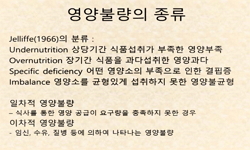This study was carried out to investigate the relationship between the food and nutrient intake status and eating-out practices of college students. A dietary survey of 361 subjects living in urban areas was conducted by using a 3-day diet record meth...
http://chineseinput.net/에서 pinyin(병음)방식으로 중국어를 변환할 수 있습니다.
변환된 중국어를 복사하여 사용하시면 됩니다.
- 中文 을 입력하시려면 zhongwen을 입력하시고 space를누르시면됩니다.
- 北京 을 입력하시려면 beijing을 입력하시고 space를 누르시면 됩니다.

A Study of the Food and Nutrient Intakes of College Students According to their Frequencies of Eating Out
한글로보기https://www.riss.kr/link?id=A106681888
- 저자
- 발행기관
- 학술지명
- 권호사항
-
발행연도
2003
-
작성언어
English
- 주제어
-
등재정보
KCI등재
-
자료형태
학술저널
-
수록면
3-11(9쪽)
- 제공처
-
0
상세조회 -
0
다운로드
부가정보
다국어 초록 (Multilingual Abstract)
This study was carried out to investigate the relationship between the food and nutrient intake status and eating-out practices of college students. A dietary survey of 361 subjects living in urban areas was conducted by using a 3-day diet record method. The average ages of the male and female subjects were 22.0 and 20.6 years old, respectively. Monthly personal expenses of the male and female students were 316,517 won and 296,888 won, respectively. 43.1% of the male and 50.8% of the female students used between one-quarter and one-half of their monthly personal expenses for eating out. Sixty-five percent of the total subjects ate out more than five times a week The average daily total food intake was 1630.7g in the males and 1453.9g in the females. The average percentage of total food intake from eating out (by weight) was 60.6% in the males and 56.2% in the females; foods eaten out were mainly potatoes, meats, processed foods, and beverages. It was found that 40-65% of daily total nutrient intake came from food eaten out. When they ate out, the male students ate slightly higher amounts of protein, fat and vitamin B1, while the female students ate relatively higher amounts of animal protein, fat, vitamin A and cholesterol. The more the subjects ate out, the more the quantity of total food intake increased. This increase resulted from high intakes of beverages and processed foods in the males, while the increase was from total plant foods, mushrooms, beverages, and milk and dairy products, in the females. The dietary variety score (DVS) was significantly increased in the female subjects when they ate out more than once a day; otherwise, the DVS was not significantly different between any of the male and female groups. The intakes of energy, and of many nutrients such as protein, fat, carbohydrates, calcium, phosphorus, iron, potassium and cholesterol, were increased when the female subjects ate out more than twice a day. The mean adequacy ratio (MAR) was at its highest level of 0.65 in the males when they ate out less than once a day, and at its highest level of 0.67 in the females when they ate out more than twice a day.
동일학술지(권/호) 다른 논문
-
- 한국영양학회
- Ho Jeung Shin
- 2003
- KCI등재
-
Perception and Need for Elderly Meal Service Program of the Korean Elderly
- 한국영양학회
- Youngmee Lee
- 2003
- KCI등재
-
- 한국영양학회
- Myung-Sook Choi
- 2003
- KCI등재
-
- 한국영양학회
- Choon Hie Yu
- 2003
- KCI등재




 ScienceON
ScienceON



